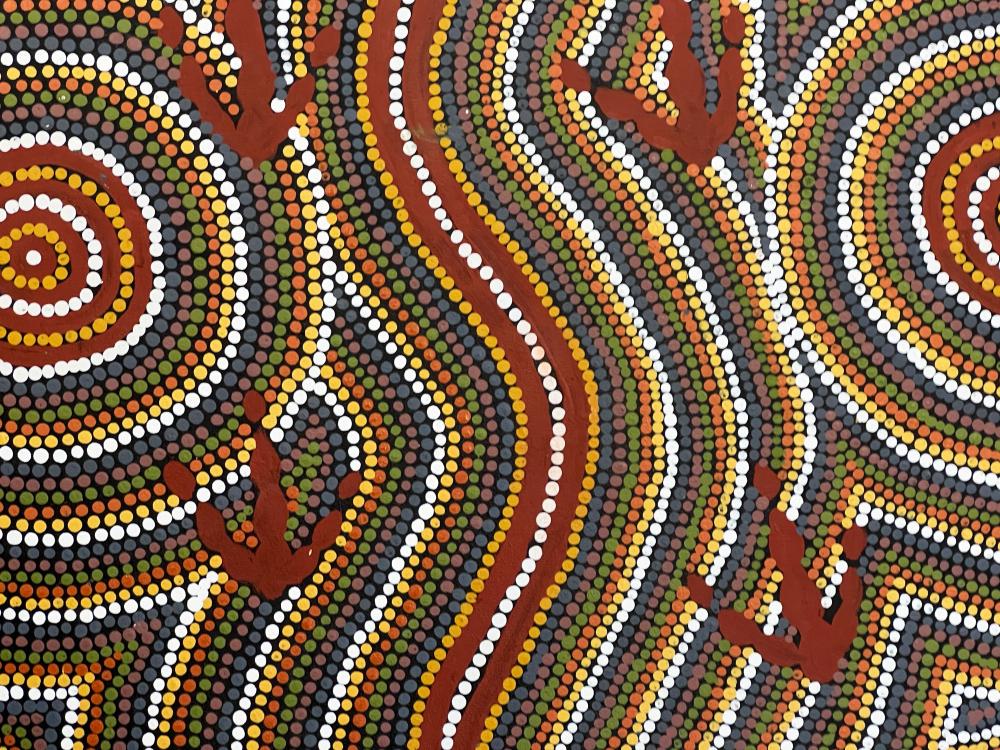
Insights into Aboriginal Art – Echoes from the Dreaming
Share
A Living Archive of the World’s Oldest Culture
Aboriginal art is not merely decoration — it is a complex language of memory, identity, land, and law. As the oldest continuous artistic tradition on Earth, with roots dating back over 60,000 years, Aboriginal art is both a vessel of ancient stories and a vibrant, evolving cultural practice.
From the ochre-painted walls of rock shelters in Arnhem Land to the bold acrylic dot paintings of Papunya Tula, Aboriginal art forms have adapted over time while remaining spiritually anchored in the Tjukurrpa — often translated as the Dreaming or Dreamtime.
Connection to Country
Every Aboriginal artwork is a map — of land, waterholes, ceremonial sites, songlines, and sacred knowledge. The term “Country” in Aboriginal culture means far more than landscape; it encompasses the physical, spiritual, and ancestral. Artists often paint their Country not from a literal perspective, but from an aerial, metaphysical view, expressing both the land’s features and its stories.
Artists such as Emily Kame Kngwarreye, Long Jack Phillipus Tjakamarra, Kathleen Petyarre, Karen Bird Ngale, Margaret Scobie and Jean Nampitjinpa embody this deep-rooted connection. Their works speak of waterholes, fire tracks, bush medicine, and ancestral spirits. Each brushstroke is a transmission of sacred knowledge, handed down through generations.
From Ceremony to Canvas
Historically, Aboriginal art was expressed through body painting, rock engravings, sand drawing, and ceremonial objects. In the 1970s, a transformative moment occurred when Aboriginal men in Papunya, under the encouragement of teacher Geoffrey Bardon, began using acrylics on canvas — giving rise to the Western Desert art movement.
This movement allowed artists to preserve cultural knowledge amid land dispossession and colonization, while also entering the global art world. Papunya Tula Artists, founded in 1972, became an internationally acclaimed collective, and their early works now fetch six- and seven-figure sums at auction.
Symbolism & Storytelling
Aboriginal art is rich in symbolism, often utilizing a language of dots, circles, lines, and tracks. While many artworks appear abstract to untrained eyes, they are dense with coded narratives:
Concentric circles may depict waterholes or campsites.
U-shapes often represent people sitting.
Lines and paths denote songlines or journeys.
Dots are used both aesthetically and as a way to conceal sacred knowledge from outsiders.
Artists may choose to share public versions of sacred stories, while protecting deeper ceremonial meanings.
Cultural Renaissance and Art Market Recognition
The 1980s and 1990s saw Aboriginal artists gain recognition in national and international exhibitions, and today, their works hang in institutions like the Tate Modern, Musée du quai Branly, and National Gallery of Australia.
Prices have soared. Emily Kame Kngwarreye’s painting Earth’s Creation sold for AUD 2.1 million, setting records for an Indigenous Australian artist.
One of Long Jack Philipus Tjakamarra pieces, Untitled (Kalipinypa) (1972), sold at Bonhams Sydney in July 2020 for AUD 231,800
Collectors and galleries alike are increasingly acknowledging the artistic, cultural, and political power of these works
Contemporary Voices & Futures
Today, Aboriginal art is dynamic and multifaceted. While desert dot painting remains iconic, contemporary Aboriginal artists explore urban identity, climate change, politics, and intergenerational trauma through photography, sculpture, digital media, and installation.
Artists like Brook Andrew, Tony Albert, and Julie Gough expand the boundaries of what Aboriginal art can be, challenging colonial narratives and asserting Indigenous perspectives in modern discourse.
Seeing with More Than Eyes
Aboriginal art invites us not just to look, but to listen — to landscapes, to ancestors, to knowledge older than writing. It is not just "art" in the Western sense; it is law, history, geography, science, and ceremony, encoded in paint. “We are painting to teach the world that our stories are still alive.”, an Aboriginal artist quote says.
To engage with Aboriginal art is to acknowledge the sovereignty and wisdom of the world’s oldest living cultures. It reminds us that stories are everywhere — in the rocks, the rivers, the skies — if only we choose to see.
Here at 24Time we celebrate Aboriginal art for its unconscious zenitude — a quiet power that radiates spirit, joy, and a deep sense of fulfillment to all who encounter it. It is also a way to pay tribute and recognize the aboriginal people and their profound spiritual culture.
Explore our curated collection of aboriginal art Here





